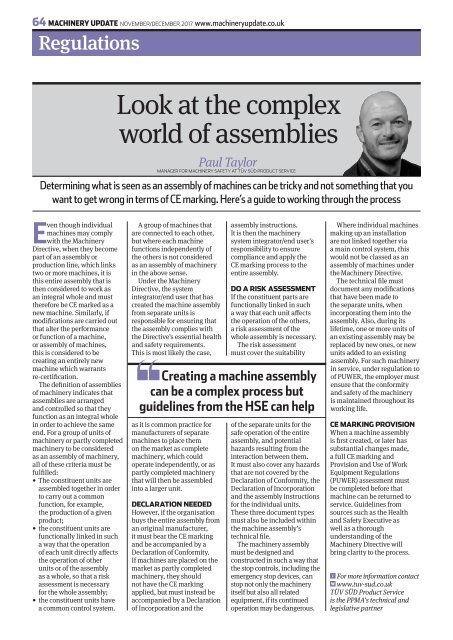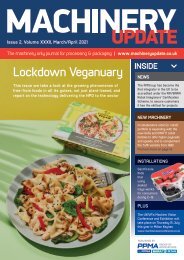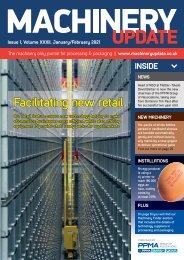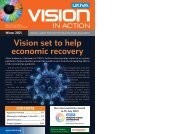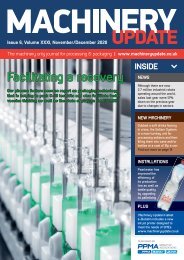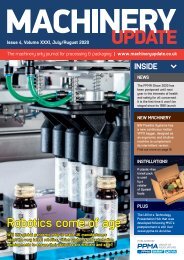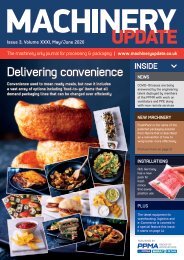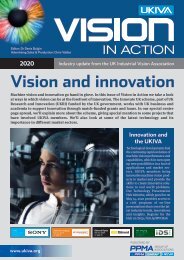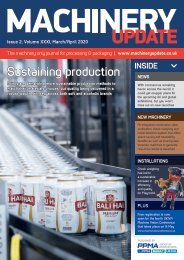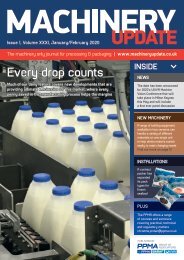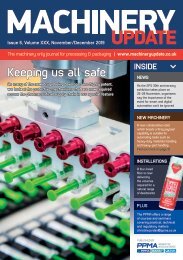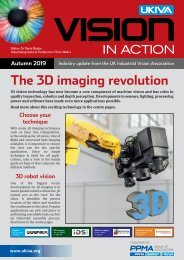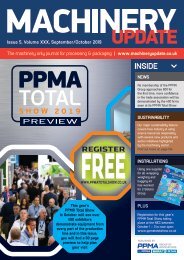MU 2017 November December
- No tags were found...
You also want an ePaper? Increase the reach of your titles
YUMPU automatically turns print PDFs into web optimized ePapers that Google loves.
64 MACHINERY UPDATE NOVEMBER/DECEMBER <strong>2017</strong> www.machineryupdate.co.uk<br />
Regulations<br />
Look at the complex<br />
world of assemblies<br />
Paul Laidler Taylor<br />
BUSINESS MANAGER DIRECTOR FOR MACHINERY FOR MACHINERY SAFETY SAFTEY AT TÜV AT SÜD TÜV PRODUCT SÜD PRODUCT SERVICE SERVICE<br />
Determining what is seen as an assembly of machines can be tricky and not something that you<br />
want to get wrong in terms of CE marking. Here’s a guide to working through the process<br />
Even though individual<br />
machines may comply<br />
with the Machinery<br />
Directive, when they become<br />
part of an assembly or<br />
production line, which links<br />
two or more machines, it is<br />
this entire assembly that is<br />
then considered to work as<br />
an integral whole and must<br />
therefore be CE marked as a<br />
new machine. Similarly, if<br />
modifications are carried out<br />
that alter the performance<br />
or function of a machine,<br />
or assembly of machines,<br />
this is considered to be<br />
creating an entirely new<br />
machine which warrants<br />
re-certification.<br />
The definition of assemblies<br />
of machinery indicates that<br />
assemblies are arranged<br />
and controlled so that they<br />
function as an integral whole<br />
in order to achieve the same<br />
end. For a group of units of<br />
machinery or partly completed<br />
machinery to be considered<br />
as an assembly of machinery,<br />
all of these criteria must be<br />
fulfilled:<br />
• The constituent units are<br />
assembled together in order<br />
to carry out a common<br />
function, for example,<br />
the production of a given<br />
product;<br />
• the constituent units are<br />
functionally linked in such<br />
a way that the operation<br />
of each unit directly affects<br />
the operation of other<br />
units or of the assembly<br />
as a whole, so that a risk<br />
assessment is necessary<br />
for the whole assembly;<br />
• the constituent units have<br />
a common control system.<br />
A group of machines that<br />
are connected to each other,<br />
but where each machine<br />
functions independently of<br />
the others is not considered<br />
as an assembly of machinery<br />
in the above sense.<br />
Under the Machinery<br />
Directive, the system<br />
integrator/end user that has<br />
created the machine assembly<br />
from separate units is<br />
responsible for ensuring that<br />
the assembly complies with<br />
the Directive’s essential health<br />
and safety requirements.<br />
This is most likely the case,<br />
as it is common practice for<br />
manufacturers of separate<br />
machines to place them<br />
on the market as complete<br />
machinery, which could<br />
operate independently, or as<br />
partly completed machinery<br />
that will then be assembled<br />
into a larger unit.<br />
DECLARATION NEEDED<br />
However, if the organisation<br />
buys the entire assembly from<br />
an original manufacturer,<br />
it must bear the CE marking<br />
and be accompanied by a<br />
Declaration of Conformity.<br />
If machines are placed on the<br />
market as partly completed<br />
machinery, they should<br />
not have the CE marking<br />
applied, but must instead be<br />
accompanied by a Declaration<br />
of Incorporation and the<br />
assembly instructions.<br />
It is then the machinery<br />
system integrator/end user’s<br />
responsibility to ensure<br />
compliance and apply the<br />
CE marking process to the<br />
entire assembly.<br />
DO A RISK ASSESSMENT<br />
If the constituent parts are<br />
functionally linked in such<br />
a way that each unit affects<br />
the operation of the others,<br />
a risk assessment of the<br />
whole assembly is necessary.<br />
The risk assessment<br />
must cover the suitability<br />
Creating a machine assembly<br />
can be a complex process but<br />
guidelines from the HSE can help<br />
of the separate units for the<br />
safe operation of the entire<br />
assembly, and potential<br />
hazards resulting from the<br />
interaction between them.<br />
It must also cover any hazards<br />
that are not covered by the<br />
Declaration of Conformity, the<br />
Declaration of Incorporation<br />
and the assembly instructions<br />
for the individual units.<br />
These three document types<br />
must also be included within<br />
the machine assembly’s<br />
technical file.<br />
The machinery assembly<br />
must be designed and<br />
constructed in such a way that<br />
the stop controls, including the<br />
emergency stop devices, can<br />
stop not only the machinery<br />
itself but also all related<br />
equipment, if its continued<br />
operation may be dangerous.<br />
Where individual machines<br />
making up an installation<br />
are not linked together via<br />
a main control system, this<br />
would not be classed as an<br />
assembly of machines under<br />
the Machinery Directive.<br />
The technical file must<br />
document any modifications<br />
that have been made to<br />
the separate units, when<br />
incorporating them into the<br />
assembly. Also, during its<br />
lifetime, one or more units of<br />
an existing assembly may be<br />
replaced by new ones, or new<br />
units added to an existing<br />
assembly. For such machinery<br />
in service, under regulation 10<br />
of PUWER, the employer must<br />
ensure that the conformity<br />
and safety of the machinery<br />
is maintained throughout its<br />
working life.<br />
CE MARKING PROVISION<br />
When a machine assembly<br />
is first created, or later has<br />
substantial changes made,<br />
a full CE marking and<br />
Provision and Use of Work<br />
Equipment Regulations<br />
(PUWER) assessment must<br />
be completed before that<br />
machine can be returned to<br />
service. Guidelines from<br />
sources such as the Health<br />
and Safety Executive as<br />
well as a thorough<br />
understanding of the<br />
Machinery Directive will<br />
bring clarity to the process.<br />
i For more information contact<br />
W www.tuv-sud.co.uk<br />
TÜV SÜD Product Service<br />
is the PPMA’s technical and<br />
legislative partner


